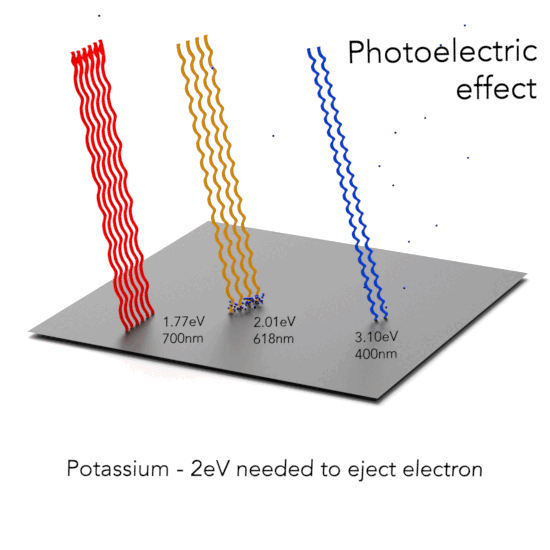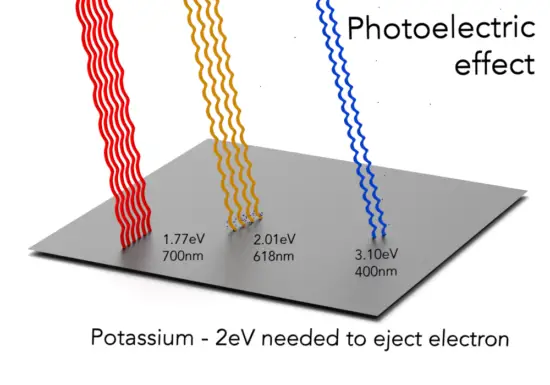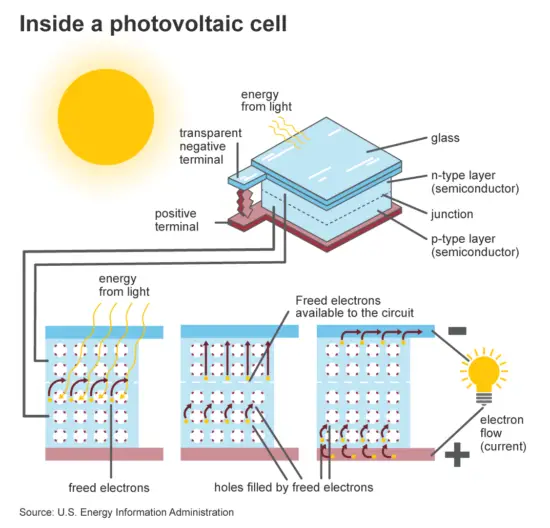30-second summary
Photoelectric Effect
In general, the photoelectric effect is the emission of photoelectrons from a material matter when electromagnetic radiation (photons) hits its surface.
The kinetic energy of the ejected photoelectron (Ee) is equal to the incident photon energy (hν) minus the binding energy of the photoelectron in its original shell (Eb).
Ee=hν-Eb
Three uses of the photoelectric effect are:
- Photovoltaic effect
- Photoemission
- Photoconduction

Photoelectric Effect
In general, the photoelectric effect is the emission of photoelectrons from a material matter when electromagnetic radiation (photons) hits its surface. In the photoelectric effect, a photon undergoes an interaction with an electron that is bound in an atom. The incident photon completely disappears in this interaction, and the atom ejects an energetic photoelectron from one of its bound shells. The kinetic energy of the ejected photoelectron (Ee) is equal to the incident photon energy (hν) minus the binding energy of the photoelectron in its original shell (Eb).
Ee=hν-Eb

Therefore, photoelectrons are only emitted by the photoelectric effect if the photon reaches or exceeds threshold energy – the electron’s binding energy – the material’s work function.
This energy transfer may dislodge electrons from their orbits around the surface of the substance. Upon losing electrons, the photosensitive (light-sensitive) material becomes positively charged, and an electric force is created. This phenomenon is called the photoelectric effect and has wide applications in electronics, such as photoelectric cells, photovoltaic cells, optical couplers, and television camera tubes.
Three uses of the photoelectric effect are described below:
- Photovoltaic effect. The light energy in one of two plates that are joined together causes one plate to release electrons to the other. The plates build up opposite charges, like a battery. The main distinction between photoelectric and photovoltaic effect is that the term photoelectric effect is now usually used when the electron is ejected out of the material (usually into a vacuum) and photovoltaic effect is used when the excited charge carrier is still contained within the material. In either case, an electric potential (or voltage) is produced by the separation of charges, and the light has to have sufficient energy to overcome the potential barrier for excitation.
- Photoemission. The photon energy from a beam of light could cause a surface to release electrons in a vacuum tube. A plate would then collect the electrons.
- Photoconduction. The light energy applied to some materials that are normally poor conductors causes free electrons to be produced in the materials so that they become better conductors.
Photovoltaic Effect
In a photovoltaic device, photons are converted into electricity. The process involves the generation of charge carriers by photon absorption, separation and transportation of the carriers, and finally their collection at electrodes.

- Photon absorption. First, photons in sunlight hit the solar panel and are absorbed by semi-conducting materials. Their energy is given to an electron in the crystal lattice. If the energy is higher than the bonding energy of the electron, the electron is freed from the bond into the conduction band where it is free to move around within the semiconductor. This results in electron-hole pair generation.
- Charge carrier separation. The most commonly known solar cell is configured as a large-area p-n junction (semiconductor structure with built-in electric field) made from silicon. As a simplification, one can imagine bringing a layer of n-type silicon into direct contact with a layer of p-type silicon. Due to the p-n junction configuration and the materials in solar cells, the electrons are only allowed to move in a single direction. The electronic structure of the materials is very important for the process to work, and often silicon incorporating small amounts of boron or phosphorus is used in different layers. The electron is pushed by this field toward the n side and the hole toward the p side.
- Charge collection and recombination. Electrons that are created on the n-type side, “collected” by the junction and swept onto the n-type side, may travel through the wire, power the load, and continue through the wire until they reach the p-type semiconductor-metal contact. Here, they recombine with a hole that was either created as an electron-hole pair on the p-type side of the solar cell, or a hole that was swept across the junction from the n-type side after being created there. An array of solar cells converts solar energy into a usable amount of direct current (DC) electricity. The voltage measured is equal to the difference in the quasi Fermi levels of the majority carriers (electrons in the n-type portion and holes in the p-type portion) at the two terminals.
Applications of Photovoltaic Effect
In most photovoltaic applications, the radiation is sunlight, and the devices are called solar cells. Nowadays, solar energy is one of the most available energies in the market. It can provide electricity to places where is no electric grid connection. Renewable energy sources are becoming more popular because the costs of PV modules have decreased in the last 5 years, and in comparison with other energy sources, it has low pollution. Solar cells are made of materials, which are called semiconductors.
In the case of a semiconductor p–n (diode) junction solar cell, illuminating the material creates an electric current because excited electrons and the remaining holes are swept in different directions by the built-in electric field of the depletion region. PV cell generates direct current (DC) from these semiconductors when they are irradiated by photons. The common single-junction silicon solar cell can produce a maximum open-circuit voltage of approximately 0.5 volts to 0.6 volts. Solar cells are usually connected in series creating an additive voltage. Connecting cells in parallel yields a higher current. Multiple solar cells in an integrated group, all oriented in one plane, constitute a solar photovoltaic panel or module. The typical open circuit voltage of a 300 watts solar panel should be around 39 volts, and short circuit current should be 8.33 amperes at a perfect angle and under full sunlight. Their lifetime can reach 20-30 years.

